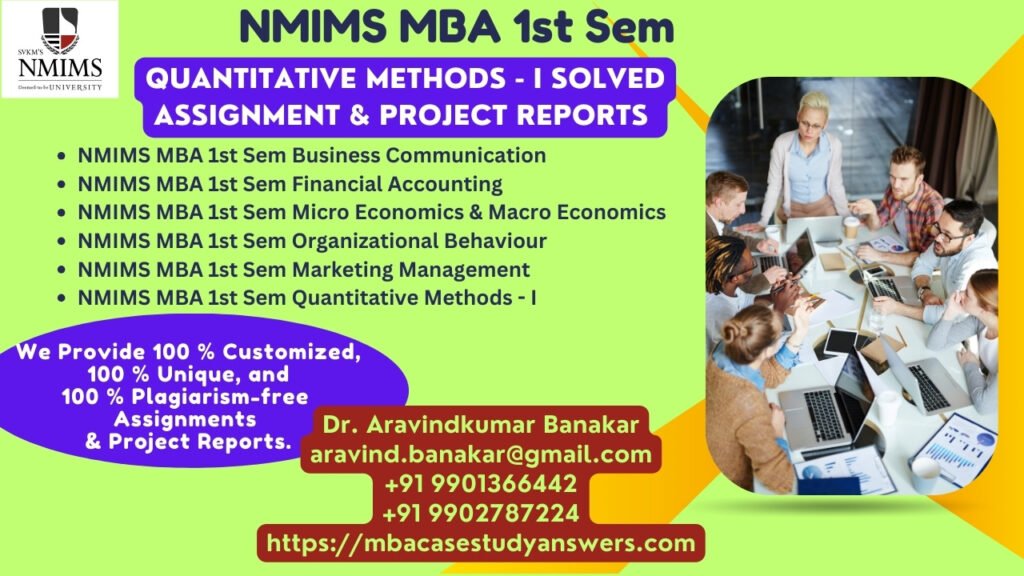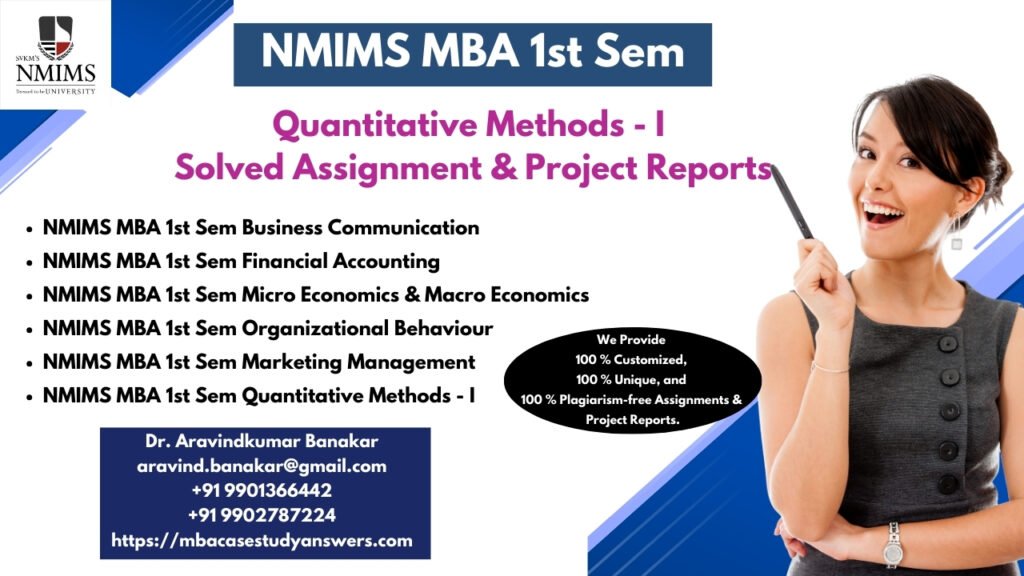NMIMS BBA – B.Com Cost and Management Accounting Solved Answer Assignment
NMIMS BBA – B.Com Cost and Management Accounting Solved Answer Assignment Ans : Cost and Management Accounting NMIMS BBA – B.Com Cost and Management Accounting Solved Answer Assignment The two major methods of costing are product costing and service costing. These two terms can be used interchangeably, but product costing is more often used in the business world. Service cost-accounting, on the other hand, is more common in the nonprofit world. Discuss any four points of difference between Service Costing and Product Costing. Share one example from the business world about any specific industry or Company using service costing or product costing Ans : Introduction: Costing plays a crucial role in both business and nonprofit organizations, with product and service costing being the primary methods. While these terms are sometimes used interchangeably, they are notable differences. NMIMS BBA – B.Com Cost and Management Accounting Solved Answer Assignment Concept & Application Product Costing: Product costing is a method organizations use to determine the cost of manufacturing or producing tangible goods. It involves allocating costs to individual product units, enabling the organization to calculate the cost of goods sold, evaluate profitability, and make informed pricing decisions. The main components of product costing include direct materials, direct labor, and manufacturing overhead. Direct materials: These are the raw materials or components that directly go into the production of the product. Each unit’s direct materials cost is allocated based on the quantity used. Direct labor includes the wages or salaries paid to the workers directly involved in the manufacturing process. The direct labor cost is assigned to each unit by calculating the hours or minutes spent on production. Conclusion: In conclusion, product and service costing are two distinct methods used to determine the costs associated with manufacturing tangible goods and providing intangible services. They differ in output, inventory management, cost object, and pricing strategy. While product costing is prevalent in the business world for tangible goods, service costing finds greater relevance in the nonprofit sector and industries providing services. NMIMS BBA – B.Com Cost and Management Accounting Solved Answer Assignment Calculate the following components from the given data for the yearly production Prime Cost Work cost Cost of Production Cost of sales Selling Value (5 marks for 5 components plus 1 mark for correct statement of cost) Number of units produced per month 1500 Cost of raw material consumed per month 36000 Labour cost incurred on a monthly basis 9000 Factory overhead incurred per month 54000 Office overhead per month 45000 Selling expenses paid per month 72000 Rate of profit 20% on the selling value Discuss and define the following related terms – cost head – 4 marks Prime cost Cost of Production Cost of Goods Sold Cost of sales Ans : Introduction: NMIMS BBA – B.Com Cost and Management Accounting Solved Answer Assignment To calculate the components, we’ll use the given monthly data and multiply it by 12 to obtain yearly values. Concept & Application Prime Cost: Prime cost refers to the direct costs incurred in the production of goods. It includes the cost of raw materials and direct labor. Prime Cost = Cost of Raw Material Consumed + Labor Cost Incurred Given data: Cost of raw material consumed per month = 36,000 Labor cost incurred on a monthly basis = 9,000 Prime Cost = (36,000 * 12) + (9,000 * 12) Prime Cost = 432,000 + 108,000 Prime Cost = 540,000 In summary, Cost of Sales is a financial metric that measures the direct expenses associated with the production or acquisition of goods or services sold by a company. It plays a vital role in determining the gross profit and gross margin, offering insights into the efficiency and profitability of a business’s core operations. Following is the cost for 500 units of bottles manufactured per month. Material 4500 Labour 1500 overheads 500 Normal waste in the process is 13% of the input a. Prepare process account. (5 Marks) (2 marks for identifying the final products manufactured and their total price +1 mark for identifying normal loss +2 marks for preparing the account) Ans : Introduction: A process account, also known as a production account or manufacturing account, is a financial statement used to track the costs incurred and output produced during a manufacturing process. It helps businesses analyze the costs involved at each stage of production and evaluate the efficiency of their manufacturing operations. Concept & Application Elaborating on the concept of a process account, here are some key points to consider: Purpose: The main purpose of a process account is to summarize and record the costs incurred in each stage of the production process, from the opening stock of raw materials to the final output. It provides a detailed breakdown of the various cost elements and helps in analyzing the overall cost of production. Conclusion In the above account, we start with the opening stock (if any), add the material purchased, and calculate the total cost available. The closing stock is subtracted to calculate the material consumed. Direct labor and overhead costs are added to determine the total cost incurred. The normal loss is deducted from the total cost incurred to arrive at the cost of the final output (bottles). Discuss any three components identified in this process account. Also, calculate the cost per unit (3+2marks) Ans : Introduction: In the given scenario, the process account for manufacturing 500 units of bottles per month includes various components. Let’s discuss three components identified in this process account: Concept & Application Material: The cost of materials is an essential component in the manufacturing process. In this case, the material cost is mentioned as 4500 units. This cost represents the expenses incurred in procuring the necessary raw materials required for manufacturing the bottles, such as plastic, caps, labels, etc. Conclusion: Since the adjusted units are negative, it indicates that the process has resulted in a loss of 85 units. Therefore, in this particular scenario, the cost per unit cannot be calculated accurately without
NMIMS BBA – B.Com Cost and Management Accounting Solved Answer Assignment Read More »









































































